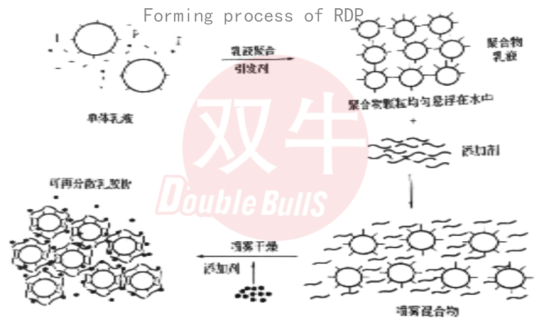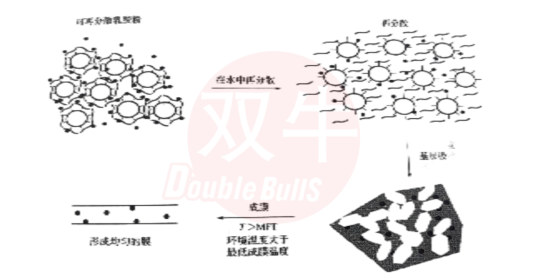Physical And Chemical Propertices
ØComposition
Including: polymerized resin, additive, protective colloid, anti-caking
a. Resinous polymer—Main ingredient for RDP to function and it is located in the core of the emulsion powder granule.
b. Additive(interior)—Modified resin, (Plasticizer for reducing the film-forming temperature of resin). Not every emulsion powder has added.
c. Additive(exterior)—Additional materials to further extend the performance of RDP. Not every emulsion powder has added.
d. Protective colloid—A layer of hydrophilic material wrapped around the surface of the RDP granule. Protective colloid : polyvinyl alcohol.
e. Anti-caking —Fine particle filler, convenient flow of emulsion powder. (Dumped from paper bag or tanker)
ØProduction process
It is mainly divided into two steps
First step: Production of polymer emulsion by emulsion polymerisation
Second step : Mixtures prepared from polymer emulsion spray drying to obtain polymer powders.

ØVariety
The main application of RDP in the market :
Vinyl acetate/Ethylene copolymer emulsion powder
Ethylene/Chloride/ Vinyl laurate ternary copolymer emulsion powder
Vinyl acetate/Ethylene and Higher fatty acid vinyl ester ternary copolymer latex powder
Vinyl acetate/Higher fatty acid vinyl copolymer latex powder
Acrylic acetate/Styrene copolymer latex powder
Vinyl acetate/Acrylic acetate and high fatty acid vinyl ester ternary copolymer latex powder
Vinyl acetate homopolymerised latex powder
Binary co-polymer emulsion powder and Ternary co-polymer emulsion powder.
Vinyl acetate and vinyl co-polymer resin remain the best technical solution, from the technical experience of polymer applied to mortar modification
because: Vinyl acetate and vinyl co-polymer resin are one of the most used polymer in the world.
Specification
| Product Specification | ||
| Chemical Name | Ethylene-vinyl acetate powder | Unit |
| Exterior | White free flowing powder | |
| Protective colloid | PVA | % |
| Solid content | 97-99 | % |
| Ash content | 10±2 13±2 15±2 | % |
| Bulk density | 300-500 | g/l³ |
| Particle size | ≥80 | μm |
| Film forming temperature | 0-5 | ℃ |
| Model | Grade | Recommended Applications |
| SN3060 | Rigid | Tile adhesive; Masonry mortar; Self-leveling mortar; Water-proofing Mortar; Repair mortar; EIFS adhesive |
| SN3080 | Flexible | Cement Plaster; Wall putty; Grout; Emulsion-based material |
Double Bulls RDP’s Advantage:
| – Supply excellent flexibility | – Improved workability |
| – High bond strength | – Reduce water absorption |
| – great durability and abrasion resistance | – Excellent rheology |
| – Increase adhesive/cohesive strength | – Higher flexural strength |
| – Improved water retention capability and open time |
Application of RDP
| – Tile adhesive/joint filler | – Skim Coat (Putty) |
| – Self-leveling mortar | – No Shrink Grout |
| – Repair mortar | – Exterior wall insulation mortars |
Packaging And Storage
vPerformance of RPD in mortar
1) Freshly mixed mortar
Improve construction performance
Improved in Flowability
Increased thixotropy and sag resistance
Improvement of cohesion
Extended opening hour and water retention
Effect of different types of RDP on the setting time of mortar.

Most type of RDP have a retarding effect on mortar. The addition of RDP in the mortar take benefit of extend the workable time of the mortar.
2) Hardened mortar
Improvement of mortar tensile strength
Enhanced flexural strength
Reduced modulus of elasticity
Improved deform-ability
Improved abrasion resistance
Increase cohesion
Decrease carbonation depth
Material reduction water absorption and hydrophobicity.
ØApplication

Online Service